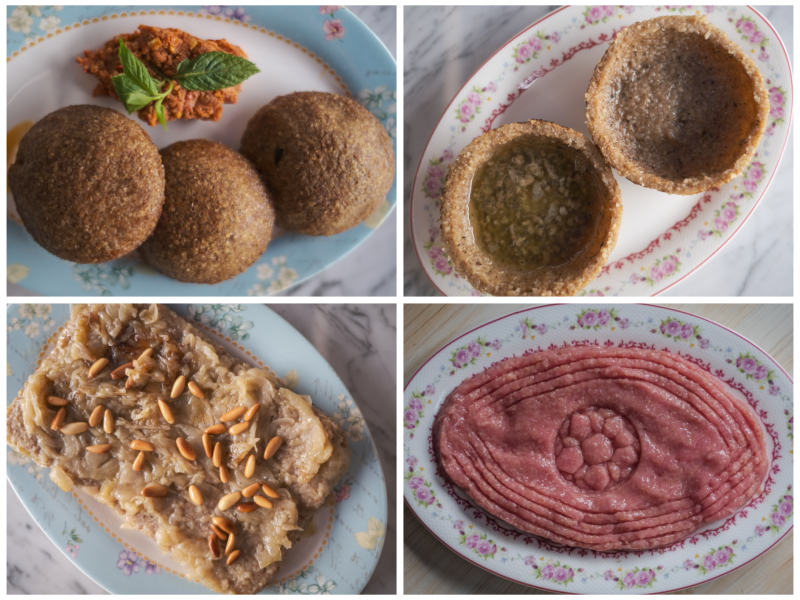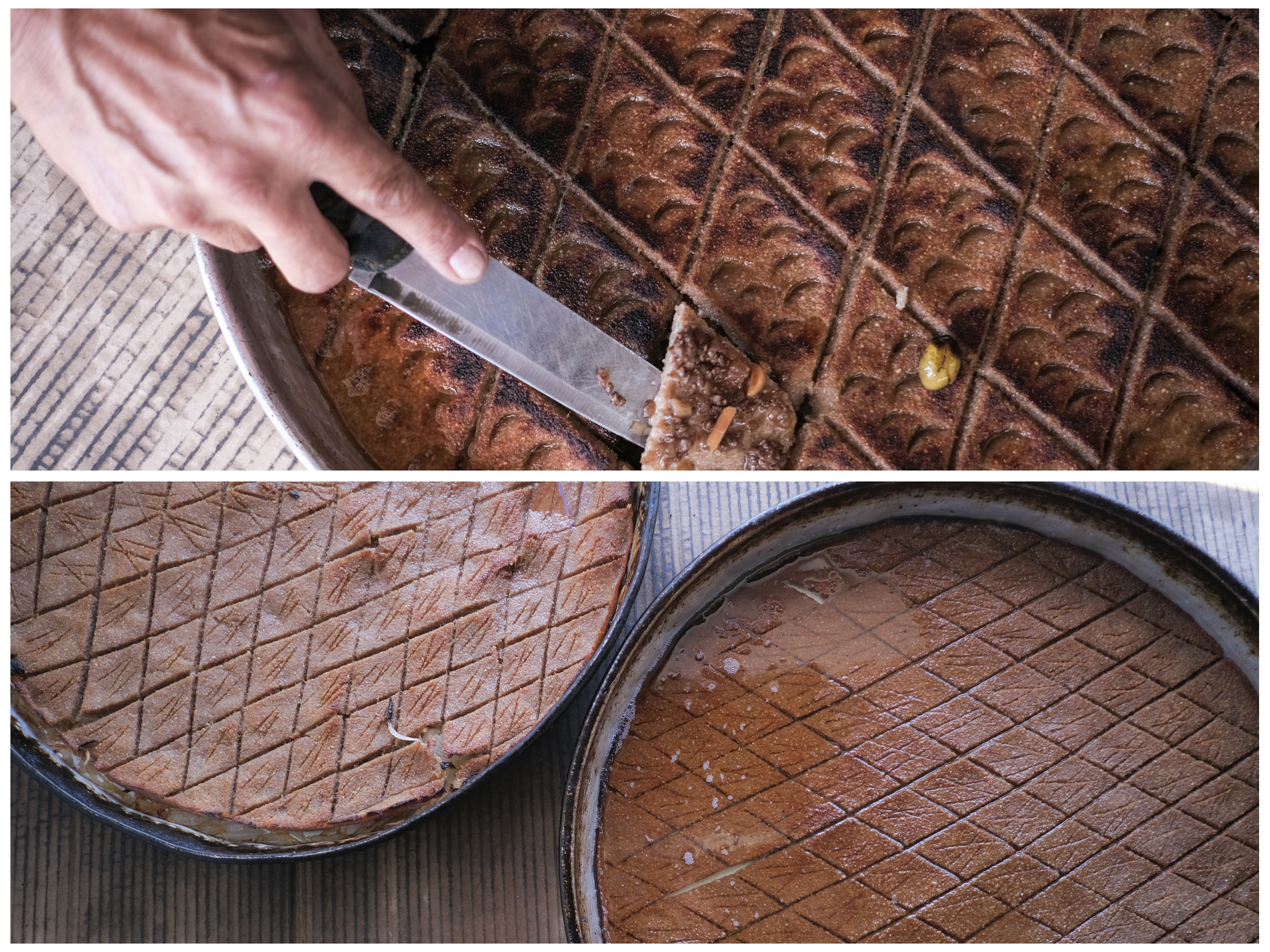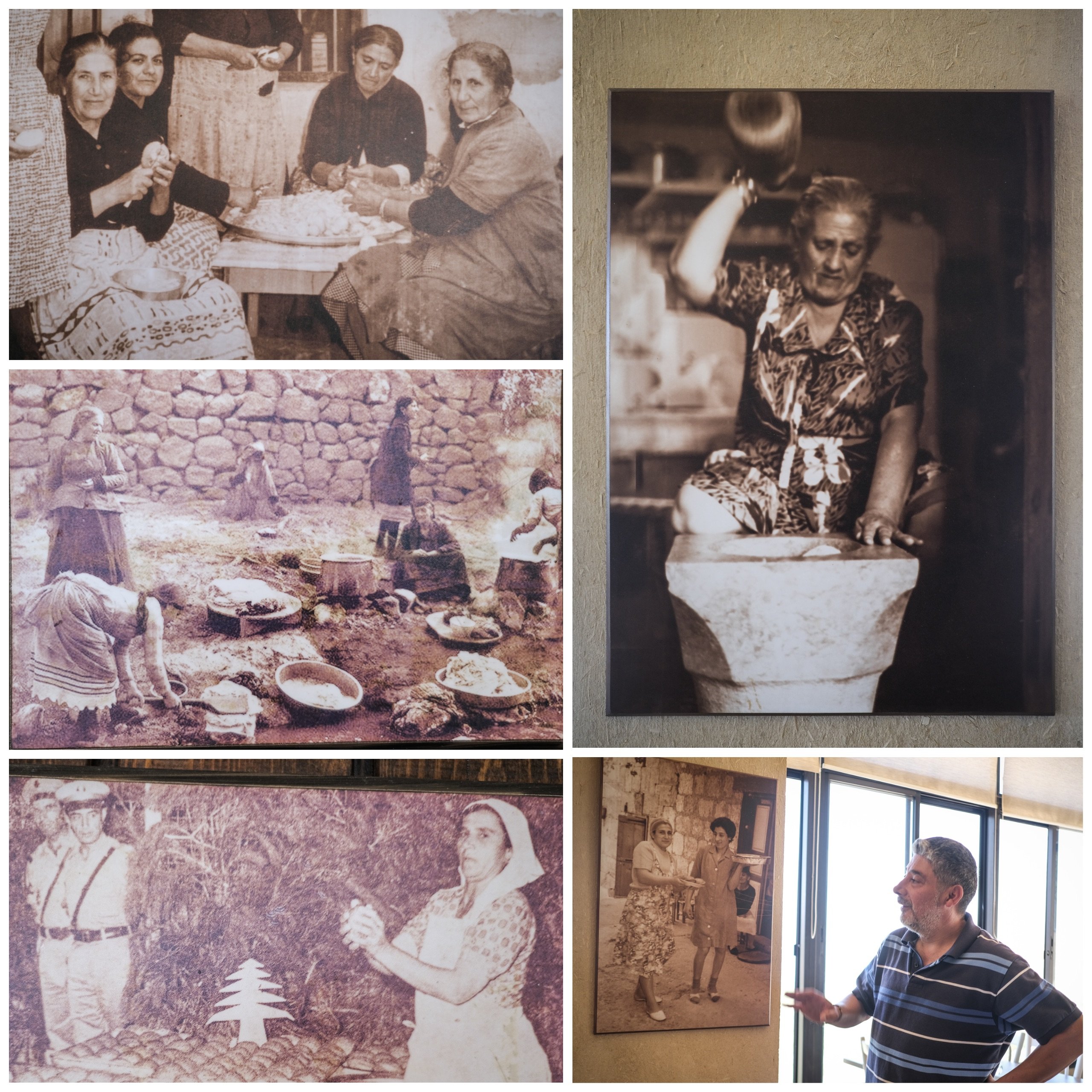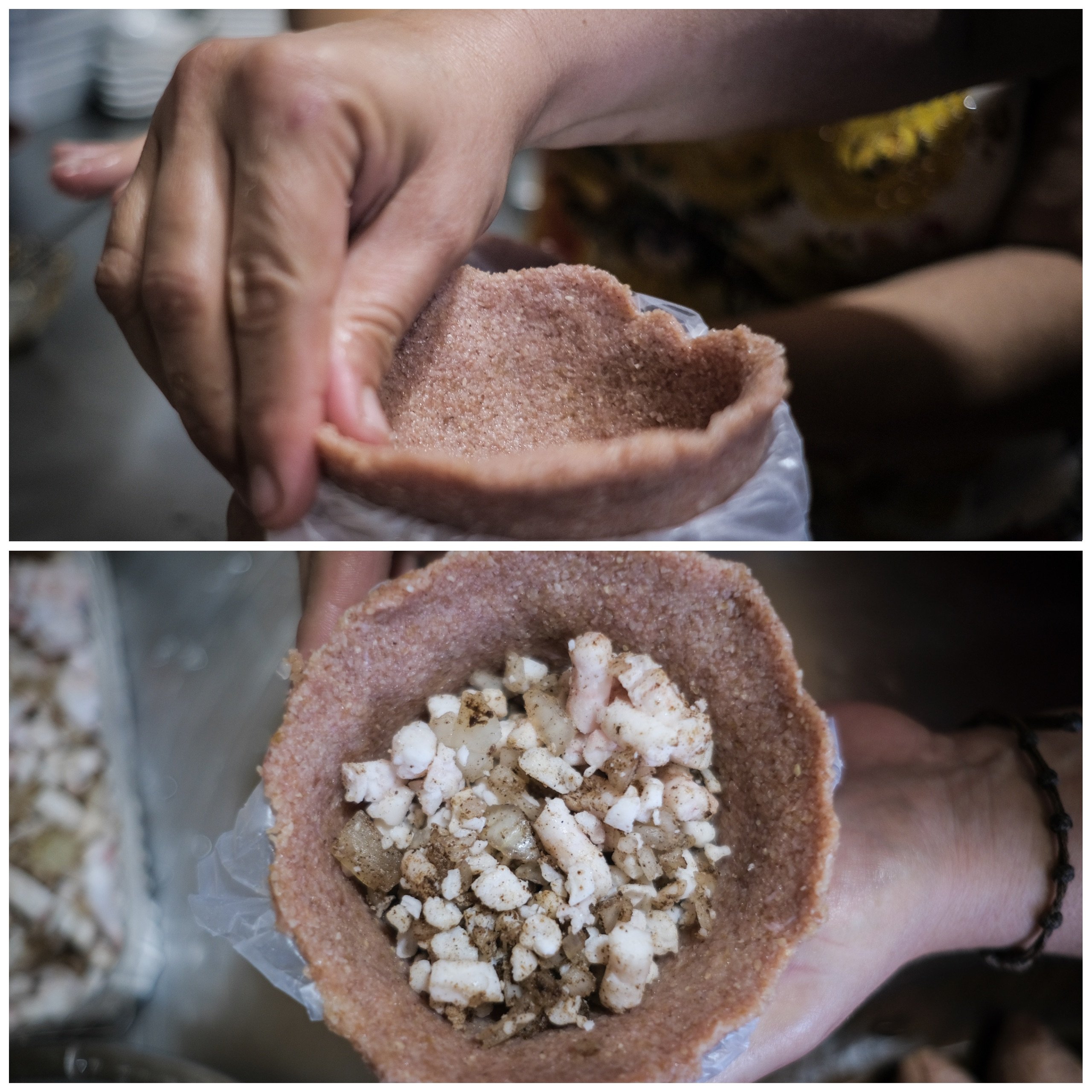
Kibbeh varieties at Joulia. (Credit: Joao Sousa/ L'Orient Today)
If kibbeh had to be described in just one word, that word would be “versatile.” Much more than a single dish, kibbeh is an umbrella classification for a wide array of dishes that can be raw, fried, boiled, baked, grilled, layered, stuffed, spread in a pan, patted into disks, meat-filled or even vegan. In its most recognized form, Kibbeh is prepared with a base mixture of burghol and meat, but the sky is the limit, and any or all its ingredients can be replaced.
Determined to track the history of this iconic linchpin of Lebanese cuisine, we met with kibbeh connoisseur Jad Abdallah, owner of Joulia, a specialty restaurant that has been serving up traditional and contemporary varieties of the dish since 2022.
Tucked away in a quiet street in the Tabaris neighborhood of Beirut’s Achrafieh quarter, the hidden, teta-esque gem elegantly fuses old village tradition with modern city tastes.
Asked why he opened a restaurant dedicated solely to kibbeh, Jad simply replied, “Because we are from Zgharta.” Enough said.
 Jad Abdallah has been running Joulia, a specialty kibbeh restaurant in Beirut, since 2022. (Credit: Joao Sousa/L'Orient Today)
Jad Abdallah has been running Joulia, a specialty kibbeh restaurant in Beirut, since 2022. (Credit: Joao Sousa/L'Orient Today)
“Kibbeh reflects our history. We come from the mountains, there were a lot of peasants and people mostly had burghul and access to goat meat. They would mix the two together. In other parts of Lebanon, they add special spices and things. We don’t do that. In Zgharta it's so simple. Meat and burghol. Salt. That’s it. No spices,” Jad says.
“I got my recipes from my mom, and my mom from my Grandma, and my grandma is Joulia, who I named the place after.”
Jad walks us through Joulia’s menu: “Here you will find classic kibbeh Zghertawiyeh, and revisited kibbeh with a twist. Some vegan options. Kibbet hummus, we make it in Zgharta during Lent. And pumpkin kibbeh of course.”
When we ask Jad what the secret behind Zgharta’s famous Kebbeh was, he pointed us to our second stop, located a couple hours north, in his hometown. A road trip is required.
The winding road to Lebanon’s ‘kibbeh capital’
After a long trip from Beirut, winding through mountains and greenery, we arrive in Ehden, the summer resort town of Zgharta residents, on a sunny Saturday morning in August. In these parts, kibbeh is close to sacred.
Our destination: Furn Ashanna.
It is there that Boulos Ashana graciously reveals the secret to Zgharta’s renowned kibbeh: communal ovens.
“Wherever you go in Zgharta they make good kibbeh, we are known for it. It’s Because of these special ovens. It's our secret, the heb [heat] is different.”
For the past 20 years, Ashana, a Zgharta native, has been running his communal furn (oven), almost exclusively reserved for baking kibbeh (and sometimes other things in trays). In the summers, he operates in Ehden, and in winter, Zgharta.
We arrive to find him busy at work, slipping trays of local home chefs’ kibbeh into the oven and removing sizzling trays cooked to perfection. He is so busy, in fact, that he can never seem to finish a cigarette — his ashtray is filled with half-smoked stubs.
 Trays of kibbeh at Furn Ashanna. (Credit: Joao Sousa/L'Orient Today)
Trays of kibbeh at Furn Ashanna. (Credit: Joao Sousa/L'Orient Today)
The phenomenon of communal kibbeh afran is today mostly unique to Zgharta and Ehden. Once abundant, afran like the one Boulos runs existed in nearly every 7ay (neighborhood). Now, only a handful remain, reflecting a dying tradition of Lebanese rural life, continued now by an aging few.
“Kibbeh is from the time of our forefathers, but its origin — I don’t know,” says Ashana, sliding a tray of layered kibbeh into the brick oven.
He offers an old wives’ tale: “But they say that nayyeh (raw kibbeh), is from the times of the Ottomans. When they came to Ehden, [the Christians] escaped to the mountains and they had goats. They couldn’t start fires [for cooking] so they don’t get caught. That’s why they started eating meat raw. One person couldn’t eat the chunks of meat because he had no teeth, so he pounded it with a pestle and mortar so he could eat it. Kibbeh nayyeh was born,” he chuckles.
“We don’t know if it’s true.”
When did kibbeh become ‘Lebanese’?
When Professor Graham Pitts was working on a book project on the famine in Lebanon, he faced a research obstacle: a lack of scholarly work on Lebanese food history.
This is why Pitts, in collaboration with other scholars from various fields, wrote the 2021 book "Making Levantine Cuisine: Modern foodways of the Eastern Mediterranean."
The books very first chapter: kibbeh.
Although kibbeh may not be exclusive to Lebanon, with variants in Syria and Palestine, it “is quintessentially Levantine,” Pitts says.
“Nobody’s talking about ‘Lebanese cuisine’ as distinct from the Levantine region, until the 1950’s,” Pitts says.
Despite being part of the Ottoman Empire since the early 16th century, the Levant had its own particular food culture. Kibbeh for instance, was common across the 19th-century Levant, but not the entire Ottoman sphere.
It wasn’t until the second half of the 20th century that cookbook authors began to name “Lebanese” cuisine as distinct from the rest of Levantine cuisine.
The first mention of kibbeh as Lebanese was in former tourism minister George al-Rayyis’ 1951 cookbook, "Kitab Fann al-Tabkh" (The Art of Cooking), which has 16 recipes for kibbeh.
After the Civil War, a new era of cookbooks seized dominance and defined Lebanese cuisine.
In, “Min Turath Lubnan” (From Lebanon’s Heritage), the Arab world’s first TV chef, the late Ramzi Choueiri, cataloged 37 kibbeh recipes, each associated with individual villages across Lebanon.
According to an interview with L'Orient Today earlier this year, the chef's favorite dish was kibbeh nayyeh.
Then vs. now
Back at Ashana’s furn, most people drop off their trays and leave to run other errands. Some linger, watching their kibbeh bake. Among them is Sarkis Fenianos, who has brought an “extra large tray” of kibbeh with him this week to “send some back to Beirut with the children.”
“Two layers, stuffed with meat, pine nuts and caramelized onion.” Ashana slips the tray into the flames.
“They just don’t make it like they used to…” Fenianos says.“They used to pound the meat using a jeren [pestle and mortar]. Everyone still has jeren around here, but they keep them as decorations. Now you buy ground meat from the shop.”
He explained that communal ovens used to run on jefet (olive remnants) before mazout, a crude form of fuel, became widely available.
“My wife makes kibbeh the new way. But the old way just tasted different. It was incomparable,” Fenianos reminisces.
Ashana interjects: “No one from the new generation really tries to learn [kibbeh making]. You have just the old generation of aging ladies. And they don’t even make it like before.”
“Everyone has ovens at home. That guy has restaurants and plenty of ovens,” says Ashana, pointing to one customer, “but he makes his kibbeh here at the furn because it’s different.” Ashana gestures at Mark Yammine, another kibbeh lover who watches with curious eyes. Yammine owns Le2meh Zghertewiyeh, a restaurant serving up home-cooked specialties.
Overhearing our conversation, Mark invites us to follow him to his family-run restaurant, offering us a demonstration of how 2ras (stuffed kibbeh disks), a unique Zgharta specialty, are made. The restaurant is a time capsule, cozy, with a breathtaking valley view.
 Portraits from the past, at Le2meh Zghartewiyeh. (Credit: Joao Sousa: L'Orient Today)
Portraits from the past, at Le2meh Zghartewiyeh. (Credit: Joao Sousa: L'Orient Today)
Its walls are adorned with black and white portraits, flashback images of the past: a kibbeh competition in Ehden from the 1950s, Mark’s mom and aunt holding trays of kibbeh, women gathered around a table peeling onions, an old woman with her arm raised above her head, pestle in hand, ready to pound meat.
Inside the busy kitchen, various kibbeh varieties are in preparation: kabkoub shells are being shaped, stuffed and carefully laid into a tray, and a vat of kibbeh labaniyeh (kibbeh in yogurt) is boiling on the stove. Tanya shapes kibbeh domes with her hands, fills one side with fat (tallow) and onion, then fuses the two sides together. These kibbeh 2ras, the best-known Zgharta specialty, will be ready for barbecue.
 Tanya Doueihy shapes domes of kibbeh. (Credit: Joao Sousa/ L'Orient Today)
Tanya Doueihy shapes domes of kibbeh. (Credit: Joao Sousa/ L'Orient Today)
Mark cuts baked kibbeh from a tray and places it on a plate for us to sample.
“Every Sunday there had to be kibbeh,” Mark chimes, echoing what nearly everyone we interviewed in the town had said.
“Back then, you could hear the pounding of pestles throughout the village.”
We ask Tanya and Mark if their sons — one of whom is a professional chef — would continue the kibbeh-making tradition. “For now, we have our health, thankfully. My chef son makes traditional food, and he also does Western food. Will he continue? I don’t know what will happen later,” Tanya responds.
Back in Beirut, Jad welcomes guests under his restaurant's breezy terrace. An azure blue awning, inscribed with “Joulia” in elegant cursive, stretches overhead. People enjoy kibbeh over chit-chat and wine.
“My grandmother Joulia had a small and simple restaurant,” he recalls. “A Lebanese restaurant in Zgharta. Her kibbeh was special. She learned it from her mom.” He pauses.
“What made it great was that it was really simple. And when I learned how to make it, I kept it that way, to preserve the history and the legacy. It carries on our identity.”
